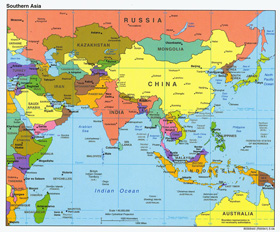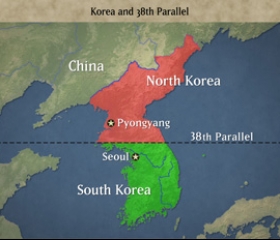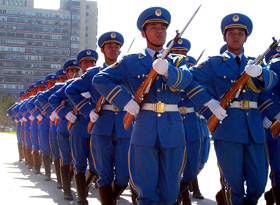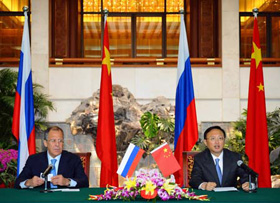One hundred years ago, most East Asian countries were at best able to relatively and successfully adapt their interests to the policies of their Western colonial powers. At the present stage of world history, eastern Asians are not so much adapting to global political and economic processes, as they form them the rather actively, and if current trends continue, East Asian countries will very likely determinesuch processes at the beginning of the next century.
Any attempt to understand the perspectives of this region cannot ignore the issue of the future borders of its member countries and territories. Time does not stand still, and these borders will inevitably change. However, under any event – whether it is the union of some states and territories, or fragmentation of others –relations between Russia and its Far Eastern neighbors have every chance to gain diversity, scale and quality and to become an important factor in mutually beneficial cooperation and co-development.
It is a very adventurous activity to make predictions for such a long historical period as a century and even more so to try to determine what will be the boundaries of a region in a hundred years time. Only because in the modern world the “region” concept has become virtual, and its boundaries may be expanded or narrowed depending on the political situation. A striking example is the relationship between the East Asia borders and the composition of participants in the East Asia Summit, which not so long ago – in the early 2000s – had thirteen states, and now, retaining its former name, has expanded to 18 members. This happened just within a decade.
In such circumstances, a more logical step would be trying to identify the fundamental factors that are most likely to increasingly influence major domestic and international processes in East Asia in its modern sense, and trying to understand how this could affect in particular the political map of the region. (We consider East Asian countries and territories to include China, Japan, North and South Korea, Taiwan, Singapore, Philippines, Brunei, Malaysia, Indonesia, Thailand, Vietnam, Laos, Cambodia, Myanmar, and East Timor.)
Drivers of change
So, if current trends continue, development of East Asia will largely depend on the following circumstances.
First, China’s influence will increase. Beijing will resort to a wide arsenal of tools – economic, political, social and cultural – to make the region a “sphere of high permeability” for its interests. Emphasis will be placed on the potential use of “soft power”, which will be flexibly and proactively adapted to changing realities.
In parallel, China is intensifying the development of its military programs, and they are unlikely to be aimed at preparing for territorial expansion – for example, the occupation of the vacant Spratly Islands in the South China Sea. Emphasis here is likely to be placed on demonstration of its growing military capabilities as a component of the country’s “complex power”.
Secondly, demographic factors will play an important role, and the main ones are the aging population in Northeast Asia and the growth of Muslims and ethnic Chinese communities in Southeast Asia.
Thirdly, the region will be subjected to an increasing influence of transnational factors, main among which will be the activities of Chinese transnational corporations. They will be heavily directed towards the support of ethnic Chinese, thereby strengthening their ties with their historical homeland.
Fourthly, the role of nationalism as a “driver” of the policies of individual countries and ethno-national identity of minorities will be strengthened.
Fifthly, the region will face a growing shortage of natural resources especially energy resources. However, the potential for the development of the innovative sectors of the economy as a prerequisite for alleviating the severity of problems in many countries will remain limited.
Finally, an important role will be played by the development of information and communication technologies that expand the ability to mobilize large numbers of people. At the same time, the passing liberalization of political and social life will objectively reduce the possibilities of countering the destructive manifestations of these processes.
The above factors will set the parameters of the most important processes in East Asia, shaping its political map.
Northeast Asia: on the way towards Sinocentrism
Unifying tendencies will prevail in Northeast Asia.
As a result, Korea will become a single state. As the range of capabilities of the North Korea both in the international arena and in carrying out necessary economic reforms narrows, Pyongyang will be more perceptible to lose the historic race with Seoul. In such circumstances, the union will occur without landslide, deliberately destructive consequences for regional stability.
At the same time, we can expect an increase in China’s influence on a unified Korea. Beijing is unlikely to give up the temptation of converting tried and tested relations with both Pyongyang and Seoul into geopolitical and geo-economic dividends, based on long-term strategic perspective.
Taiwan will become a part of China. The key to this is the strengthening of the complex interdependence of the island and the mainland, which will eventually turn into an asymmetric dependence. As a result, the problem will be peacefully solved on Beijing’s terms. The issue of Tibet will be resolved similarly. Sound economic and migration policies of the Chinese authorities will play a key role here.
Sea territorial disputes, especially the ones concerning the Senkaku Islands, will be resolved in China’s favor. However, there is objectively little reason to expect that China will review the parameters of resolving disputes at its land borders.
In parallel with this, China will intensify development of its naval programs, and will come out not only for the “first”, but also for the “second” chain of islands. Consequently, the naval forces of a combined Chinese state will control the major shipping routes and strategically important straits of the Yellow and East China Seas.
Southeast Asia: meeting the challenges of ethnic nationalism
Southeast Asia may witness fragmentation of the currently existing states, which will be primarily determined by ethnic nationalism. Territories, where new states could be formed are:
– South of Thailand and the Philippines, where local Muslim communities can establish an independent state, if the authorities continue the policy of ignoring economic demands of the people living there and solving the problem by military means;
– Myanmar, where, if current trends continue, the national issue will be far from being resolved due to the unreadiness of the central authorities to develop the institutions of the representative government in the national margins and expand the powers of local legislative and executive power (Kachin State is the most likely to separate).
The national issue will remain difficult both in Indonesia and in Malaysia as well. In Indonesia, individual recurrence of violence in Aceh province and West Irian cannot be excluded. Antagonisms between the Malay, Chinese and Indian communities will remain in Malaysia. However, the issues will not reach to the extent of formation of new states. The key to this in Indonesia will be the reforms aimed at alleviating the severity of problems that have accumulated, while in Malaysia, besides its own reforms, development of the innovative sectors of the economy will be a key factor in keeping the situation under control.
This course of events will require ASEAN to involve supranational mechanisms to prevent escalation of the internal problems of its member countries. Accordingly, it is logical to expect that ASEAN will be forced to change its fundamental principles of cooperation in the international arena – primarily, reviewing its thesis of non-interference in the internal affairs of sovereign states.
Territorial disputes in the South China Sea have all the chances to be settled in China’s favor since the influence of the American factor on the evolution of the problem will decrease with time. As a result, this area of water may de facto become China’s “internal waters”. The severity of other territorial conflicts will fade with time.
Russia in East Asia: the process has begun
East Asia will become the de facto central focus of Russian foreign policy. At the same time, Russia will succeed in the economic development of Siberia and the Far East, with emphasis on the development of innovative industries. This will open up a wide range of opportunities of cooperation for Moscow with Far Eastern neighbors, and its main directions will be the following.
1. Energy. Russia’s role in ensuring energy security of its Far Eastern neighbors has the potential of increasing, especially given the growth of their dependence on energy.
2. Food security. The currently abandoned arable lands of Siberia and the Far East will be used in cooperating with East Asian countries, and Russia has all the chances to become the breadbasket of the region.
3. Transportation. East Asians will actively carry cargo along the Trans-Siberian Railway and the Northern Sea Route. Simultaneously, Russia together with the United States will build a tunnel under the Bering Strait, which will find a positive response from its Far Eastern neighbors.
4. Social capital. With the development of own innovative productions, especially in the Far East, Russia will be actively involved in international cooperation on preparation of the necessary personnel. The effect will be mutually beneficial for both Russia, and its East Asian partners.
The above will also determine the state of relations between Russia and individual countries in East Asia.
The Russian-Chinese cooperation will become deep, complex and diversified and will cover a wide range of different directions, pushing Moscow and Beijing to overcome differences and find mutually acceptable solutions. The grounds for reviewing the terms of settlement of border and territorial disputes between the two countries are objectively small.
Russia’s relations with a united Korea will also experience positive trends. The parties will implement a number of mutually beneficial projects on transport and energy, establish cooperation in the innovative sectors of the economy, build strong ties both at the level of large corporations, and at the level of small and medium-sized businesses.
It can be assumed that in the future, the Russian-Japanese dispute over the southern ridge of Kuril Islands would be settled in favor of Russia. The key to this will be, firstly, the activation of the Far Eastern vector of Russia’s policy, and secondly, China’s support for the Russian position, some elements of which are already emerging at the present time, and thirdly, the relative decline of U.S. influence on major political and economic processes in the region.
Relations between Russia and the countries of South-East Asia will develop in a positive way. Russia will move away from the focus on energy exports by strengthening its innovative component. The growth of Russia’s influence on the activities of the major areas of multilateral diplomacy, where ASEAN serves as the “driving force”, seems logical.
Overall, leaving aside the question of whether Asiacentrism will replace Eurocentrism in Russia’s policy, there are all reasons to expect its position to strengthen in East Asia. It seems our Far Eastern neighbors will only welcome this development.
* * *
Practice, which is the only criterion of truth, will show how far the author’s predictions will coincide with actual course of events. However, the advantage of expert’s fantasy is the possibility of applying a nontrivial approach to understanding the many processes that have every chance to shape the future of dynamically developing East Asia.
Many things can occur in this region in the next hundred years, considering the fact that, at this stage, it is impossible to predict anything, let alone comprehend. However, two key points are still visible. First – countries in the region will most likely be able to avoid a large-scale military conflict. The second point is that Russia will considerably contribute to the realization of this scenario mainly for no other reason than due to the fact that Russia has the ability and, more importantly, the political will to realize this scenario.








